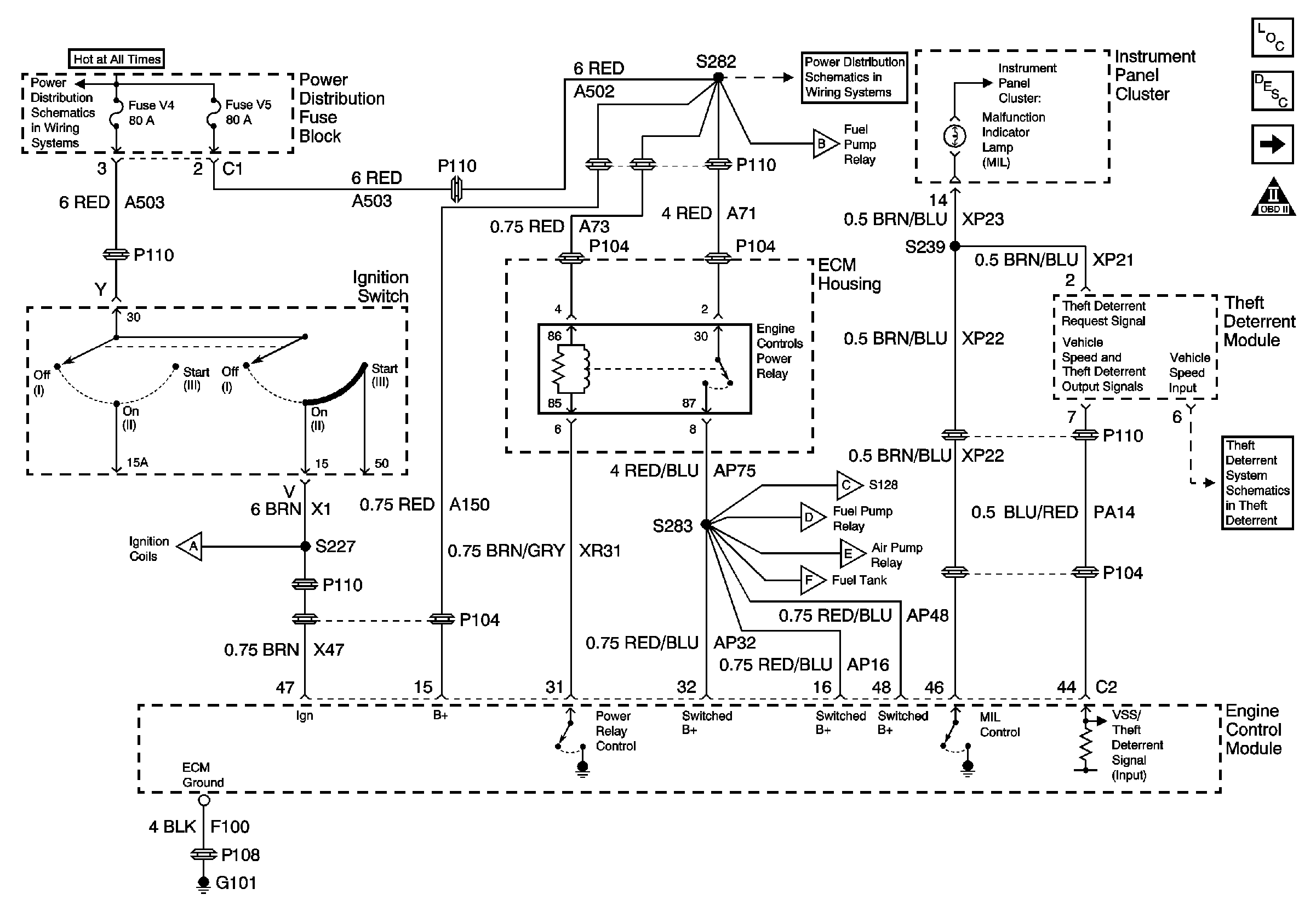Circuit Description
The engine controls power relays coil and contacts are connected directly to the battery positive voltage (B+). The engine control module (ECM) controls the relay by grounding the control circuit through an internal solid state device called a driver. When the ECM detects a voltage on the ignition feed circuit, the ECM enables the engine controls power relay. The engine controls power relay controls the switched B+ circuit to the fuel pump relay coil, the fuel injectors, the heated oxygen sensor (HO2S) heaters and the other engine control components that use a switched B+ supply. The ECM also uses the switched B+ circuit to power up a portion of itself, including the circuitry which controls the malfunction indicator lamp (MIL) operation.
Diagnostic Aids
Use the J 35616 Connector Test Adapter Kit for any test that requires probing the ECM harness connector or a component harness connector.
Intermittent connections may cause the engine to stall or an intermittent loss of communication. Loss of the switched B+ voltage may cause multiple DTCs to set.
Test for poor connections at the ECM or at the component. Check all other circuits that are spliced to the engine controls power relay for the proper operation. Inspect the harness connectors for intermittent or poor connections. Refer to Testing for Intermittent Conditions and Poor Connections .
Refer to Symptoms - Engine Controls or Intermittent Conditions for the intermittents.
Test Description
The number below refers to the step number on the diagnostic table.
Step | Action | Values | Yes | No | ||||||||||||
|---|---|---|---|---|---|---|---|---|---|---|---|---|---|---|---|---|
Schematic Reference:
| ||||||||||||||||
1 | Did you perform the Diagnostic System Check-Engine Controls? | -- | Go to Step 2 | |||||||||||||
2 |
Does the test lamp illuminate on both circuits? | -- | Go to Step 3 | Go to Step 12 | ||||||||||||
3 |
Does the test lamp illuminate? | -- | Go to Step 10 | |||||||||||||
4 |
Does the test lamp illuminate? | -- | Go to Step 11 | Go to Step 5 | ||||||||||||
5 |
Does the test lamp illuminate? | -- | Go to Step 6 | Go to Step 8 | ||||||||||||
6 |
Is the amperage within the specified range? | 100-200 mA | Go to Step 7 | Go to Step 14 | ||||||||||||
7 |
Does the test lamp illuminate on all three circuits? | -- | Go to Step 15 | Go to Step 9 | ||||||||||||
8 |
Did you find and correct the condition? | -- | Go to Step 18 | Go to Step 13 | ||||||||||||
9 |
Did you find and correct the condition? | -- | Go to Step 18 | Go to Step 13 | ||||||||||||
10 | Repair the short to voltage in the engine controls power relay control circuit. Refer to Wiring Repairs in Wiring Systems. Did you complete the repair? | -- | Go to Step 18 | -- | ||||||||||||
11 | Repair the short to ground in the engine controls power relay control circuit. Refer to Wiring Repairs in Wiring Systems. Did you complete the repair? | -- | Go to Step 18 | -- | ||||||||||||
12 | Repair the battery feed circuit. Refer to Wiring Repairs in Wiring Systems. Did you complete the repair? | -- | -- | |||||||||||||
13 |
Did you find and correct the condition? | -- | Go to Step 18 | Go to Step 14 | ||||||||||||
14 | Replace the relay. Did you complete the replacement? | -- | Go to Step 18 | -- | ||||||||||||
Did you find and correct the condition? | -- | Go to Step 18 | Go to Step 16 | |||||||||||||
16 | Inspect the ECM harness connector for a poor connection or poor terminal tension. Refer to Testing for Intermittent Conditions and Poor Connections . If a repair is necessary, refer to Connector Repairs in Wiring Systems. Did you find and correct the condition? | -- | Go to Step 18 | Go to Step 17 | ||||||||||||
17 |
Important:
Replace the ECM. Refer to Engine Control Module Replacement . Did you complete the action? | -- | Go to Step 18 | -- | ||||||||||||
18 |
Can communication be established with the ECM? | -- | System OK | |||||||||||||

